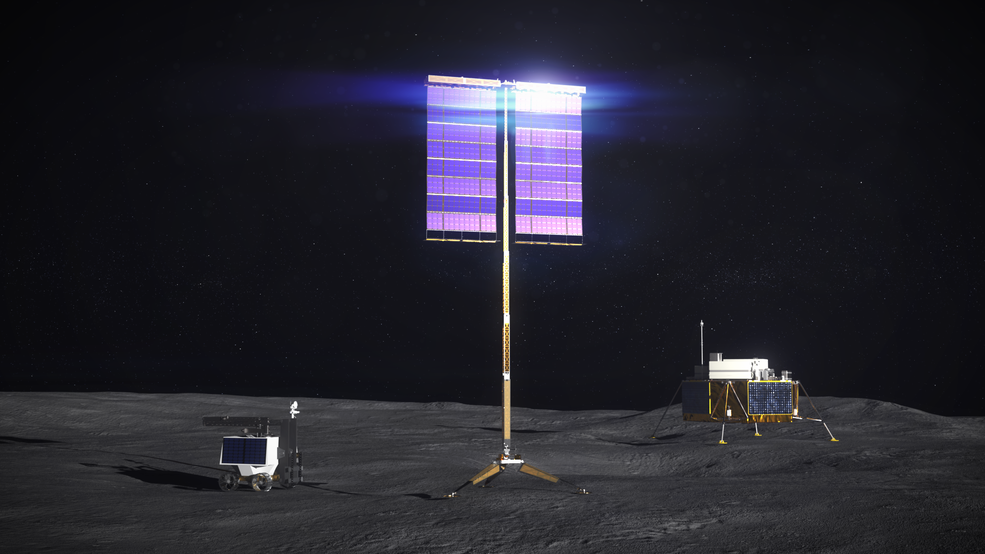Three Companies to Help NASA Advance Solar Array Technology for Moon
Through Artemis missions, NASA will return humans to the Moon and establish a long-term presence near the lunar South Pole. A reliable, sustainable power source is required to support lunar habitats, rovers, and even construction systems for future robotic and crewed missions. To help provide this power, NASA is supporting development of vertical solar arrays that can autonomously deploy up to 32 feet high and retract for relocation if necessary.
通过阿尔忒弥斯号任务,美国宇航局将把人类送回月球,并在月球南极附近建立长期存在。需要一种可靠的、可持续的电源来支持月球栖息地、漫游者,甚至是未来机器人和载人任务的建造系统。为了帮助提供这种电力,NASA正在支持垂直太阳能阵列的开发,这种阵列可以自主部署到32英尺高,并在必要时可以重新移动。
“These prototypes will provide promising solutions for reliable power sources on the Moon, which are key to the success of almost anything we do on the surface,” said Niki Werkheiser, director of technology maturation in NASA’s Space Technology Mission Directorate (STMD) at NASA Headquarters in Washington. “This exciting effort plays a critical role that will quite literally help power our Artemis exploration in the uniquely challenging environment of the Moon’s South Pole.”
“这些原型将为月球上可靠的电源提供有前景的解决方案,这是我们在月球表面几乎任何事情成功的关键,”位于华盛顿的NASA总部的NASA空间技术任务理事会(STMD)的技术成熟主任Niki Werkheiser说。“这一令人兴奋的努力发挥了关键作用,将帮助我们在月球南极独特的富有挑战性的环境中进行阿尔忒弥斯号探索。”
The agency will award a total of $19.4 million to three companies to build prototypes and perform environmental testing, with the goal of deploying one of the systems near the Moon’s South Pole near the end of this decade. The designs must remain stable on sloped terrain and be resistant to abrasive lunar dust, all while minimizing both mass and stowed volume to aid in the system’s delivery to the lunar surface. The awards include:
该机构将向三家公司提供总计1940万美元的资金,用于建造原型并进行环境测试,目标是在本十年结束时在月球南极附近部署其中一个系统。设计必须在倾斜的地形上保持稳定,并抵抗月球表面的磨蚀性粉尘,同时最小化质量和装载体积,以帮助系统交付到月球表面。奖项包括:
- Astrobotic Technology of Pittsburgh, Pennsylvania: $6.2 million
- 宾夕法尼亚州匹兹堡的Astrobotic技术公司:620万美元
- Honeybee Robotics of Brooklyn, New York: $7 million
- 纽约布鲁克林的蜜蜂机器人公司:700万美元
- Lockheed Martin of Littleton, Colorado: $6.2 million
- 科罗拉多州利特尔顿的洛克希德·马丁公司:620万美元
Existing space-rated solar array structures are designed for use in microgravity or for horizontal surface deployment. The vertical orientation and height of these new designs will help prevent loss of power at the lunar poles where the Sun does not rise very far above the horizon. When the Sun is low on the horizon, the Moon’s terrain can block some of its light, keeping it from reaching solar arrays that are low to the ground. By placing the solar arrays on tall masts, these designs allow for uninterrupted light and therefore produce more power.
现有的空间额定太阳能阵列结构设计用于微重力或水平表面部署。这些新设计的垂直方向和高度将有助于防止在月球两极的电力损失,因为那里的太阳上升距离地平线并不很远。当太阳处于地平线的低处时,月球的地形会阻挡部分光线,使光线无法到达低至地面的太阳能电池板。通过将太阳能阵列放置在高高的桅杆上,这些设计允许不间断的光线,从而产生更多的电力。
“We are very excited to be able to select these three teams as they all bring very different technological solutions as well as unique visions for how commercial space can support a sustained presence on the Moon,” said Chuck Taylor, Vertical Solar Array Technology (VSAT) project manager at NASA’s Langley Research Center in Hampton, Virginia.
位于弗吉尼亚州汉普顿的美国宇航局兰利研究中心垂直太阳能阵列技术(VSAT)项目经理查克·泰勒表示:“我们非常高兴能够选择这三个团队,因为他们都带来了非常不同的技术解决方案,以及对商业空间如何支持在月球上持续存在的独特愿景。”
Read more at Nasa.gov











